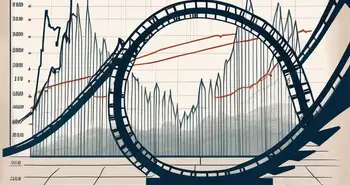Unveiling the Perils of Bear Trap Stocks: A Comprehensive Guide

Are you an investor looking to navigate the treacherous waters of the stock market? If so, then bear trap stocks are something you need to be aware of. In this comprehensive guide, I will be unveiling the perils of bear trap stocks and providing you with valuable insights on how to identify and avoid them. So, let's dive in!
Understanding Bear Trap Stocks
Before we dive into the dangers and strategies associated with bear trap stocks, let's first understand what they are. Bear trap stocks are deceptive market conditions that give the illusion of a potential downtrend. They lure unsuspecting investors into selling their stocks, only for the market to suddenly reverse and potentially cause significant losses.
But what exactly makes bear trap stocks so deceptive? Let's explore the definition and characteristics of bear trap stocks in more detail.
Definition and Characteristics of Bear Trap Stocks
Bear trap stocks are characterized by a temporary decline in prices, often accompanied by negative news or market sentiment. This decline causes panic among investors, leading them to sell their stocks out of fear. However, this decline is usually short-lived and followed by a sudden upward reversal, trapping those who sold in a panic.
Imagine a scenario where a company releases a disappointing earnings report, causing its stock price to plummet. This negative news triggers a wave of panic selling, with investors rushing to get rid of their shares before the situation worsens. Little do they know, this decline is just a bear trap.
As the panic selling intensifies, the smart and experienced investors recognize the trap and see an opportunity. They understand that the decline is temporary and that the stock's true value may not be accurately reflected in the current market sentiment. These savvy investors patiently wait for the right moment to strike.
And then it happens – the market suddenly reverses. Positive news emerges, or a significant investor expresses confidence in the company's future prospects. The stock price shoots up, catching those who sold in a panic off guard. They find themselves trapped in a situation where they have to buy back the stocks at a higher price, incurring losses in the process.
The Mechanism of Bear Trap Stocks
The mechanism behind bear trap stocks lies in the psychology of market participants. When investors see prices declining, they tend to assume that the trend will continue. This fear-driven selling creates a self-fulfilling prophecy, causing prices to drop even further.
Imagine a crowded room where everyone is rushing towards the exit. People start panicking, assuming that there must be a fire or some imminent danger. In reality, it might just be a false alarm, but the fear spreads like wildfire, causing chaos and confusion. The same principle applies to bear trap stocks.
However, smart investors who recognize this trap can take advantage of the panic selling and buy stocks at discounted prices. They understand that the market is driven by emotions and that fear can cloud judgment. By staying calm and analyzing the situation objectively, these investors can make informed decisions and potentially profit from the bear trap.
It's important to note that bear trap stocks are not always easy to identify. They require careful analysis of market conditions, news, and investor sentiment. Successful navigation of bear trap stocks requires a combination of experience, knowledge, and a keen eye for spotting potential traps.
In conclusion, bear trap stocks are deceptive market conditions that lure unsuspecting investors into selling their stocks, only for the market to suddenly reverse and potentially cause significant losses. Understanding the definition, characteristics, and mechanism behind bear trap stocks can help investors navigate these treacherous waters and potentially turn a bear trap into a profitable opportunity.
The Dangers of Bear Trap Stocks
Now that we understand the basics of bear trap stocks, let's delve into the dangers associated with them.
Bear trap stocks, as the name suggests, can be extremely dangerous for investors who are not well-informed or experienced in the stock market. These stocks can lure investors into a false sense of security, only to trap them in a downward spiral of financial losses.
Financial Risks Involved
One of the biggest risks of bear trap stocks is the potential for significant financial losses. Investing in bear trap stocks without proper knowledge and analysis can lead to selling at the bottom and missing out on potential gains when the market reverses. It is crucial to take a cautious approach and thoroughly analyze the market conditions before making any investment decisions.
When investors fall into the bear trap, they often panic and sell their stocks at a loss, fearing that the downward trend will continue indefinitely. However, what they fail to realize is that bear trap stocks can sometimes experience sudden reversals, catching those who sold off guard and causing them to miss out on potential profits.
Furthermore, the volatility of bear trap stocks can make it difficult to accurately predict their future movements. It requires a deep understanding of market trends, technical analysis, and the ability to identify potential bear traps before they ensnare unsuspecting investors.
Impact on Market Sentiment
Bear trap stocks can have a significant impact on market sentiment. When investors witness sudden reversals, it creates confusion and uncertainty. The fear and uncertainty generated by bear trap stocks can spread like wildfire, causing a domino effect that affects not only the specific stocks involved but also the overall market sentiment.
As investors witness others falling into the bear trap, they may lose confidence in the market as a whole. This loss of confidence can lead to a decrease in buying activity and an increase in selling pressure, further exacerbating the downward trend. The negative sentiment can become self-perpetuating, making it even more challenging for the market to recover.
It is important to be aware of these market dynamics and remain calm during such situations to make rational investment decisions. Panic selling or buying based on emotional reactions can lead to significant financial losses. Instead, investors should focus on conducting thorough research, seeking expert advice, and staying updated with the latest market trends to navigate the dangers of bear trap stocks successfully.
Identifying Bear Trap Stocks
Now that we understand the dangers associated with bear trap stocks, let's focus on how to identify them to avoid falling into the trap.
Bear trap stocks can be a nightmare for investors, causing significant losses and eroding confidence in the market. However, with careful analysis and attention to key indicators, it is possible to spot these traps before they ensnare unsuspecting traders.
Key Indicators to Watch Out For
One of the key indicators of bear trap stocks is a sudden and sharp decline in prices accompanied by negative news. Pay attention to any news that could potentially influence the market sentiment. For example, a company facing a major lawsuit or regulatory scrutiny may experience a significant drop in stock price. This negative news can create panic among investors, leading to a bear trap scenario.
Another important indicator to watch out for is volume patterns. A sudden increase in trading volume may indicate a bear trap in progress. When a stock is being heavily sold off, it can create a false impression of a downward trend, luring in more sellers. However, savvy investors who closely monitor volume patterns can identify this abnormal activity and avoid falling into the trap.
Analyzing Market Trends and Patterns
Analyzing market trends and patterns is vital in identifying potential bear trap stocks. Look for patterns such as a quick decline followed by a sudden recovery. This pattern, known as a “dead cat bounce,” occurs when a stock experiences a temporary rebound after a significant drop. While this may seem like a positive sign, it can often be a bear trap in disguise. Investors who fail to recognize this pattern may be tempted to buy the stock, only to see it plummet further.
It is also important to consider broader market trends when assessing the potential for bear traps. During a bear market, where overall market sentiment is negative and stock prices are falling, the likelihood of bear trap stocks increases. In such conditions, even seemingly attractive stocks may be part of a larger bear trap strategy employed by market manipulators.
Furthermore, analyzing historical data and conducting thorough research on a company's financial health and industry trends can provide valuable insights into the potential for bear traps. By studying past instances of bear traps and understanding the factors that contributed to their occurrence, investors can better equip themselves to identify and avoid similar situations in the future.
Strategies to Avoid Bear Trap Stocks
Now that we know how to identify bear trap stocks, let's explore some strategies to steer clear of them.
But first, let's understand what a bear trap stock is. A bear trap stock refers to a situation in the stock market where the price of a stock appears to be reversing from a downward trend, leading investors to believe that it is a good time to buy. However, the stock price then continues to decline, trapping those investors in a losing position.
Importance of Diversification
One of the most effective strategies to avoid bear trap stocks is to diversify your investment portfolio. By spreading your investments across different sectors and asset classes, you minimize the impact of any individual stock's performance. Diversification helps protect your portfolio from the risk associated with specific stocks.
For example, let's say you have a portfolio that consists solely of technology stocks. If the technology sector experiences a downturn, your entire portfolio would be at risk. However, if you had diversified your portfolio by including stocks from other sectors such as healthcare, consumer goods, or energy, the negative impact of the technology sector downturn would be mitigated.
Furthermore, diversification can also involve investing in different asset classes such as bonds, real estate, or commodities. This further reduces the risk of being trapped in a single stock or sector.
The Role of Fundamental Analysis
As an investor, it is crucial to conduct thorough fundamental analysis before investing in any stock. Evaluate the company's financial health, growth prospects, and management quality. By focusing on the fundamentals, you mitigate the risk of falling into a bear trap and can make informed investment decisions.
When conducting fundamental analysis, it is important to assess the company's financial statements, including its balance sheet, income statement, and cash flow statement. Look for signs of financial stability, such as consistent revenue growth, manageable debt levels, and positive cash flow.
Additionally, consider the company's growth prospects. Is it operating in a growing industry? Does it have a competitive advantage? Are there any potential risks or challenges that could impact its future performance?
Furthermore, evaluating the quality of the company's management team is essential. Look for experienced and capable executives who have a track record of making sound business decisions. A strong management team can navigate through challenging market conditions and minimize the risk of falling into a bear trap.
By combining diversification with thorough fundamental analysis, you can significantly reduce the risk of being trapped in bear trap stocks. Remember, investing in the stock market always carries some level of risk, but by implementing these strategies, you can make more informed and prudent investment decisions.
Navigating Bear Trap Stocks
Now that we have explored the dangers and strategies associated with bear trap stocks, let's discuss how to navigate them effectively.
When to Hold and When to Sell
Knowing when to hold and when to sell is key to navigating bear trap stocks successfully. It's important to have a predefined exit strategy and stick to it. Set specific price targets or stop-loss orders to protect your investments. Additionally, keep a close eye on market trends and patterns to identify any potential reversals.
The Importance of Patience and Discipline
Patience and discipline are virtues that every investor must cultivate. When faced with bear trap stocks, it's crucial to stay calm and avoid making impulsive decisions. Stick to your investment plan and trust your analysis. Remember that successful investing requires a long-term approach.
As an experienced investor, I have personally witnessed the perils and pitfalls of bear trap stocks. I once found myself trapped in a bear trap stock due to panic selling. However, that experience taught me valuable lessons in staying informed, conducting proper analysis, and avoiding knee-jerk reactions.
FAQ
What are bear trap stocks?
Bear trap stocks are deceptive market conditions that give the illusion of a potential downtrend. They lure unsuspecting investors into selling their stocks, only for the market to suddenly reverse and potentially cause significant losses.
How can I identify bear trap stocks?
To identify bear trap stocks, pay attention to sudden declines in prices accompanied by negative news. Look for patterns of quick declines followed by sudden recoveries.
What strategies can I use to avoid bear trap stocks?
To avoid bear trap stocks, diversify your investment portfolio and conduct thorough fundamental analysis before making any investment decisions. Set predefined exit strategies and stick to them.
When faced with bear trap stocks, what should I do?
When faced with bear trap stocks, it's important to stay calm, stick to your investment plan, and avoid making impulsive decisions. Have patience and trust your analysis.
By understanding the perils of bear trap stocks, identifying their characteristics, and implementing smart investment strategies, you can navigate the market with confidence and avoid falling into the bear trap. Remember, investing is a journey, and becoming an informed and disciplined investor takes time and experience. Stay vigilant, stay informed, and happy investing!
Ready to take control of your trading experience and avoid the pitfalls of bear trap stocks? Join Morpher today and revolutionize your investing journey. With Morpher's zero-fee structure, infinite liquidity, and the ability to trade across a multitude of asset classes, you're empowered to navigate the markets with confidence. Whether you're looking to invest fractionally, short sell without interest fees, or leverage your trades up to 10x, Morpher provides the tools you need for a unique and innovative trading experience. Plus, with the safety and control of a non-custodial Morpher Wallet, you can trade with peace of mind. Sign Up and Get Your Free Sign Up Bonus now, and start trading the smart way with Morpher.

Disclaimer: All investments involve risk, and the past performance of a security, industry, sector, market, financial product, trading strategy, or individual’s trading does not guarantee future results or returns. Investors are fully responsible for any investment decisions they make. Such decisions should be based solely on an evaluation of their financial circumstances, investment objectives, risk tolerance, and liquidity needs. This post does not constitute investment advice.

Painless trading for everyone
Hundreds of markets all in one place - Apple, Bitcoin, Gold, Watches, NFTs, Sneakers and so much more.

Painless trading for everyone
Hundreds of markets all in one place - Apple, Bitcoin, Gold, Watches, NFTs, Sneakers and so much more.








